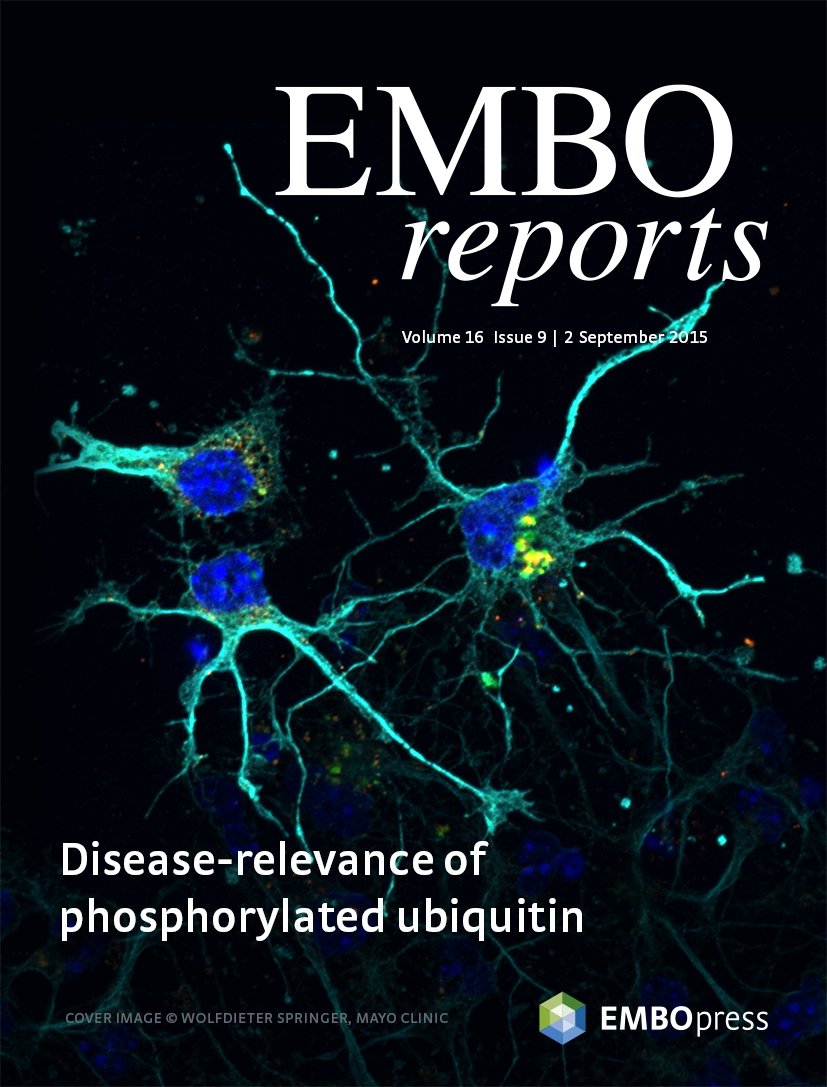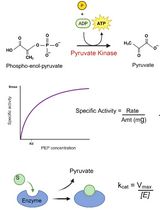- EN - English
- CN - 中文
Non-radioactive in vitro PINK1 Kinase Assays Using Ubiquitin or Parkin as Substrate
采用泛素蛋白或酵素作为底物的非放射性体外PINK1激酶实验
发布: 2016年10月05日第6卷第19期 DOI: 10.21769/BioProtoc.1946 浏览次数: 8840
评审: Ralph BottcherQiangjun ZhouVanesa Olivares-Illana
Abstract
This protocol describes the in vitro phosphorylation of ubiquitin and Parkin by the kinase PINK1 using recombinant proteins. Both substrates, ubiquitin and Parkin, are phosphorylated at the conserved serine 65 residue (pS65-ubiquitin and pS65-Parkin). The protocol also includes the use of monomeric and K48- and K63-linked poly-ubiquitin chains as alternative substrates. Although there are commercially available antibodies, we have not tested their performance in this assay since, but used validated antibodies from our laboratory. An alternative antibody-independent method, the use of phos-tag gels to detect pS65-ubiquitin and pS65-Parkin, is described in addition.
Keywords: PINK1 (PINK1)Background
In cells, PINK1 is stabilized and activated by mitochondrial membrane depolarization and other forms of stress that lead to mitochondrial damage. Activated PINK1 phosphorylates ubiquitin, which acts as the receptor for the cytosolic E3 ubiquitin ligase Parkin on the mitochondrial surface. Phosphorylation of Parkin by PINK1 is required for full activity of Parkin towards mitochondrial substrates. The presence of active pS65-Parkin amplifies in a feed-forward mechanism the amount of pS65-ubiquitin on mitochondria, which acts as the mitophagy tag. Eventually, damaged mitochondria are being recognized by autophagy adapters and will be degraded by the proteasome and by autophagy (mitophagy). This crucial mitochondrial quality control pathway promotes turnover of mitochondria and prevents accumulation of dysfunctional mitochondria that can lead to cellular degeneration. Loss-of-function mutations in either PINK1 or Parkin are associated with early-onset Parkinson’s disease.
In cell-free ubiquitination assays, the presence of pS65-Ub activates the E3 ligase activity of Parkin also in the absence of active PINK1. While many groups use their own purified recombinant proteins for in vitro PINK1 kinase assays, this optimized protocol describes the in vitro phosphorylation of ubiquitin and Parkin with commercially available recombinant proteins.
Materials and Reagents
- Recombinant proteins
- Active PINK1 [MBP-tagged] from Tribolium castaneum (Ubiquigent, catalog number: 66-0043-050 )
- Inactive PINK1 D359A [MBP-tagged] from Tribolium castaneum (Ubiquigent, catalog number: 66-0044-050 )
- Parkin (untagged) (Ubiquigent, catalog number: 63-0048-025 )
- Ubiquitin (untagged) (BOSTON BIOCHEM, catalog number: U-100H )
- Ubiquitin N-terminal biotin (BOSTON BIOCHEM, catalog number: UB-560 )
- Biotinylated poly-ubiquitin chains (K48-linked) (BOSTON BIOCHEM, catalog number: UCB-230 )
- Poly-ubiquitin chains (K63-linked) (Biotinylated) (BOSTON BIOCHEM, catalog number: UCB-330 )
- Active PINK1 [MBP-tagged] from Tribolium castaneum (Ubiquigent, catalog number: 66-0043-050 )
- Chemicals for buffers
- HEPES (Sigma-Aldrich, catalog number: H4034 )
- DL-dithiothreitol (DTT) (Sigma-Aldrich, catalog number: D0632 )
- Ethylene glycol-bis(2-aminoethylether)-N,N,N’,N’-tetraacetic acid (EGTA) (Sigma-Aldrich, catalog number: E3889 )
- EDTA (EMD Millipore, catalog number: EX0539 )
- ATP (AppliChem, catalog number: A1348 )
- Magnesium chloride hexahydrate (MgCl2·6H2O) (Sigma-Aldrich, catalog number: M0250 )
- Potassium hydroxide (KOH) (Sigma-Aldrich, catalog number: 60370 )
- Tris (Santa Cruz Biotechnology, catalog number: sc-3715 )
- Hydrochloric acid (37%) (EMD Millipore, catalog number: 1003172500 )
- Sodium dodecyl sulfate (SDS) (Sigma-Aldrich, catalog number: L4509 )
- Glycerol (Thermo Fisher Scientific, Fisher Scientific, catalog number: BP2291 )
- β-mercaptoethanol (Sigma-Aldrich, catalog number: M3148 )
- Bromophenol blue sodium salt (Sigma-Aldrich, catalog number: B5525 )
- Glycine (Sigma-Aldrich, catalog number: G7126 )
- Methanol (Pharmco-Aaper, catalog number: 339000000 )
- Dry milk powder
- Bovine serum albumin (BSA) (Sigma-Aldrich, catalog number: A9647 )
- Sodium chloride (NaCl) (Thermo Fisher Scientific, Fisher Scientific, catalog number: BP358-10 )
- Tween-20 (Sigma-Aldrich, catalog number: P1379 )
- Potassium chloride (KCl) (Sigma-Aldrich, catalog number: P3911 )
- Sodium phosphate dibasic (Na2HPO4) (Sigma-Aldrich, catalog number: S5136 )
- Potassium phosphate monobasic (KH2PO4) (Sigma-Aldrich, catalog number: P5655 )
- 10x kinase buffer (see Recipes)
- 6x SDS loading buffer (see Recipes)
- SDS running buffer (see Recipes)
- Blotting buffer (see Recipes)
- TBST (see Recipes)
- Resolving gel buffer (see Recipes)
- 14% resolving phos-tag gel (recipe for mini gel) (see Recipes)
- 8% resolving phos-tag gel (recipe for mini gel) (see Recipes)
- Stacking gel buffer (see Recipes)
- Stacking gel (recipe for two mini gels) (see Recipes)
- Phos-tag gel washing buffer 1 (see Recipes)
- Phos-tag gel washing buffer 2 (see Recipes)
- Phosphate buffer saline (PBS) (see Recipes)
- Antigen retrieval solution (see Recipes)
- HEPES (Sigma-Aldrich, catalog number: H4034 )
- SDS-PAGE/Western blot
- 8-16% Tris-glycine gels (for Parkin) (Thermo Fisher Scientific, InvitrogenTM, catalog number: EC60485BOX )
- 16% Tris-glycine gels (for ubiquitin) (Thermo Fisher Scientific, InvitrogenTM, catalog number: EC64985BOX )
- Pre-stained protein ladder (Bio-Rad Laboratories, catalog number: 1610394 )
- PVDF membrane (EMD Millipore, catalog number: IPVH00010 )
- pS65-Parkin antibody (Abcam, catalog number: ab154995 )
- pS65-Ubiquitin antibody (EMD Millipore, catalog number: ABS1513-I or BOSTON BIOCHEM, catalog number: A-110 )
- Monoclonal Parkin antibody Prk8 (Cell Signaling Technology, catalog number: 4211 )
- Monoclonal Ubiquitin antibody (LifeSensor, catalog number: VU-101 )
- PierceTM streptavidin, HRP-linked (Thermo Fisher Scientific, Thermo ScientificTM, catalog number: 21130 )
- HRP-conjugated anti-rabbit antibodies (Jackson Immunoresearch, catalog number: 111-035-003 )
- HRP-conjugated anti-mouse antibodies (Jackson Immunoresearch, catalog number: 115-035-003 )
- Western blot detection reagent (EMD Millipore, catalog number: WBKLS0500 )
- X-ray films (Genesee Scientific, catalog number: 30-101L )
- Acrylamide:Bis-acrylamide 19:1, solution 40% (w/v) (EMD Millipore, catalog number: 1290-OP )
- Zinc chloride (ZnCl2) (Sigma-Aldrich, catalog number: 96468 )
- Ammonium persulfate [(NH4)2S2O8] (Sigma-Aldrich, catalog number: A9164 )
- TEMED (Santa Cruz Biotechnology, catalog number: sc-29111 )
- Phos-tagTM acrylamide AAL-107 (Wako Pure Chemical Industries, catalog number: 304-93521 )
- 25% glutaraldehyde solution (Sigma-Aldrich, catalog number: G6257 )
- 8-16% Tris-glycine gels (for Parkin) (Thermo Fisher Scientific, InvitrogenTM, catalog number: EC60485BOX )
Equipment
- Standard bench-top centrifuge
- Heated shaker for microtubes [e.g., Thermomixer (Eppendorf, catalog number: 5384000020 )]
- SDS-PAGE gel electrophoresis and blotting boxes (e.g., VWR International, Peqlab, catalog number: 45-1010-C and Bio-Rad Laboratories, catalog number: 1704070 )
- Orbital shaker for Western blots
- X-ray film processor or camera detection system (e.g., GE Healthcare, catalog number: 28-9558-10 ) to visualize chemiluminescent Western blot signal
Software
- ImageJ or ImageStudio Lite
Procedure
文章信息
版权信息
© 2016 The Authors; exclusive licensee Bio-protocol LLC.
如何引用
Readers should cite both the Bio-protocol article and the original research article where this protocol was used:
- Fiesel, F. C., Hudec, R. and Springer, W. (2016). Non-radioactive in vitro PINK1 Kinase Assays Using Ubiquitin or Parkin as Substrate. Bio-protocol 6(19): e1946. DOI: 10.21769/BioProtoc.1946.
- Fiesel, F. C., Ando, M., Hudec, R., Hill, A. R., Castanedes-Casey, M., Caulfield, T. R., Moussaud-Lamodiere, E. L., Stankowski, J. N., Bauer, P. O., Lorenzo-Betancor, O., Ferrer, I., Arbelo, J. M., Siuda, J., Chen, L., Dawson, V. L., Dawson, T. M., Wszolek, Z. K., Ross, O. A., Dickson, D. W. and Springer, W. (2015). (Patho-)physiological relevance of PINK1-dependent ubiquitin phosphorylation. EMBO Rep 16(9): 1114-1130.
分类
神经科学 > 细胞机理 > 线粒体
生物化学 > 蛋白质 > 修饰
生物化学 > 蛋白质 > 活性
您对这篇实验方法有问题吗?
在此处发布您的问题,我们将邀请本文作者来回答。同时,我们会将您的问题发布到Bio-protocol Exchange,以便寻求社区成员的帮助。
提问指南
+ 问题描述
写下详细的问题描述,包括所有有助于他人回答您问题的信息(例如实验过程、条件和相关图像等)。
Share
Bluesky
X
Copy link














